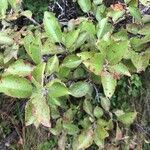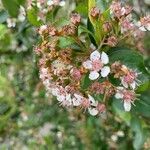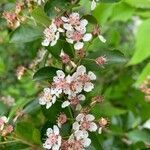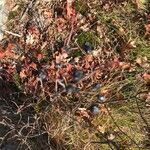A shrub. It is similar to red chokeberry. It is a lower more spreading shrub. It grows 1-2 m high. The stems are more crowded. It has suckers and forms thickets. The leaves are less glossy. The leaves are bright green and smooth. They have small black glands along the upper midribs. The leaves turn orange in autumn. The flowers are small and white. They are produced in clusters or about 10. The fruit are berries which are black when ripe. They are 8-12 mm across. The flesh is red. They drop soon after they ripen.
Stems glabrous or glabrescent. Leaves pale green abaxially, dark green and shiny adaxially, becoming scarlet; blade 2.5–7 × 2.5–3.5 cm, apex subacute to acuminate or apiculate, surfaces glabrous or glabrescent, adaxial midrib stipitate-glandular. Flowers sweet-scented; hypanthium glabrous; sepal margins glabrous; anthers yellow to purplish red. Pomes black, glabrous, taste acid and bitter. 2n = 34, 68.









